Frogs, toads, salamanders, and newts, oh my!
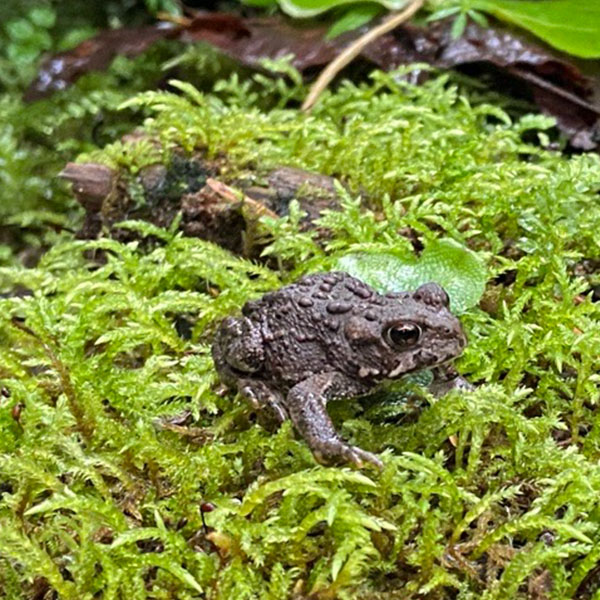
Western toad © Tesia Forstner. Used with permission.

Western toad © Tesia Forstner. Used with permission.
How does this align with my curriculum?
Learn about amphibians, their life in the coastal temperate rainforest biome, and how you can help them out!
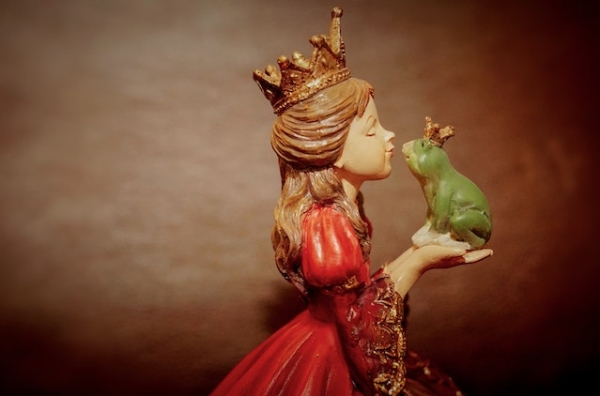
Image - Text Version
Shown is a colour photograph of a sculpture of a young person kissing a frog.
The sculpture is painted in bright glossy colours and set against a beige background. The person is wearing a long red gown and a pointed gold crown. A large green frog is sitting in their hands. It is also wearing a gold crown. The person's lips are pursed, near the frog's face.
Amphibian Basics
Amphibians are vertebrates, meaning they are animals with a backbone. They are also cold-blooded, which means their body temperature varies with that of the environment. Amphibians, unlike people, cannot generate their own internal heat. People and other mammals are considered warm-blooded because their body temperature is different from the environment.
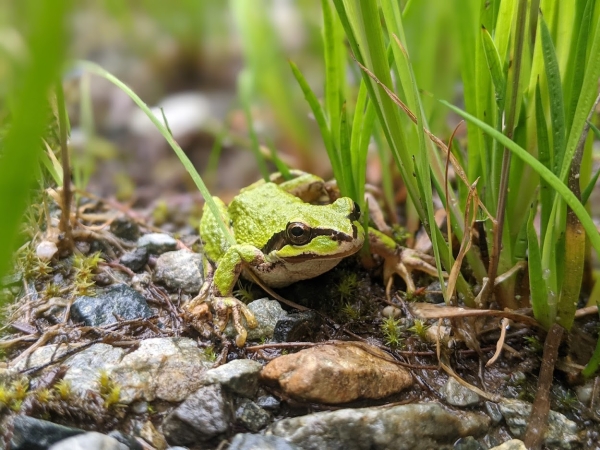
Image - Text Version
Shown is a colour photograph of a green frog on wet rocks, surrounded by long grass.
The camera is low to the ground, and the frog is in the centre of the image. It appears to be in mid-stride, moving across the rocks. It is bright green with a dark brown V that crosses both eyes and comes to a point below its nostrils.
The rocks are shiny with moisture and surrounded on all sides by long green grass.
Amphibians are special because they breathe through their lungs and through their skin! They can even absorb water through their skin instead of drinking it with their mouths.
Amphibians must stay wet, otherwise their skin will dry out and they won’t be able to breathe. As useful as their skin is, it also allows chemicals and other harmful things from the environment to enter their bodies, meaning that amphibians are especially sensitive to pollutants. Because of this, you might actually make an amphibian sick if you touched it with chemicals on your hands like sunscreen or bug spray. So it's best to not touch amphibians – and definitely don’t kiss them!
What is the difference between frogs and toads, salamanders and newts?
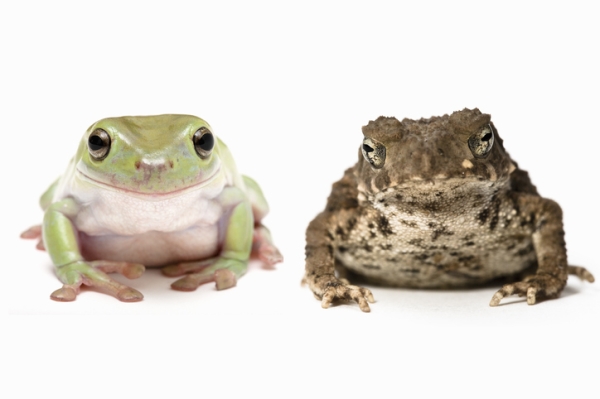
Image - Text Version
Shown is a close-up colour photograph of a frog and a toad on a white background.
Both animals face forward, towards the camera. On the left, the frog has a white underbelly and pale green head and limbs. It is shiny with moisture.
On the right, the toad has dry, rough, lumpy skin. It is wider than the frog, with a larger head. Its underbelly is beige speckled with dark brown. Its head and limbs are brown.
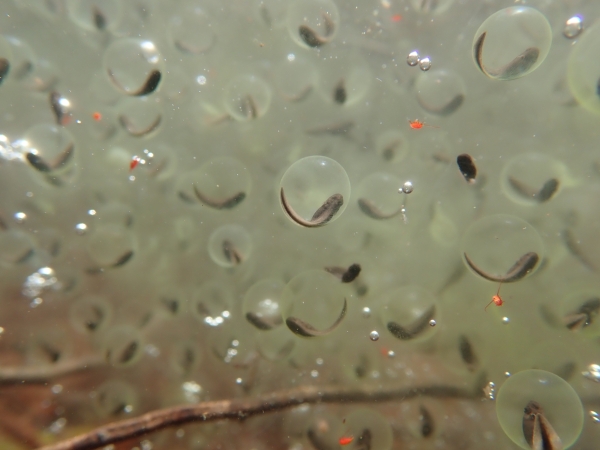
Image - Text Version
Shown is an underwater colour photograph of dozens of transparent spheres with tadpoles inside.
The spheres look like large bubbles suspended in pale green water. Each one has a long, thin brown shape inside. These are all curved, lying across the bottoms of the spheres.
In the bottom left of the image are two twigs, lying on a beige surface.
Image - Text Version
Shown is a colour photograph of a long animal with an orange belly in a forest.
Half the animal's length is its thick, straight tail. Its body is a little wider and rounder than its tail. It is low to the ground, with four, short, webbed feet. It has a snub nose and large, round eyes.
The animal is walking over pale gold wood. Behind it are fallen logs covered in green moss. Light is visible through tall, thin evergreen trees in the background.
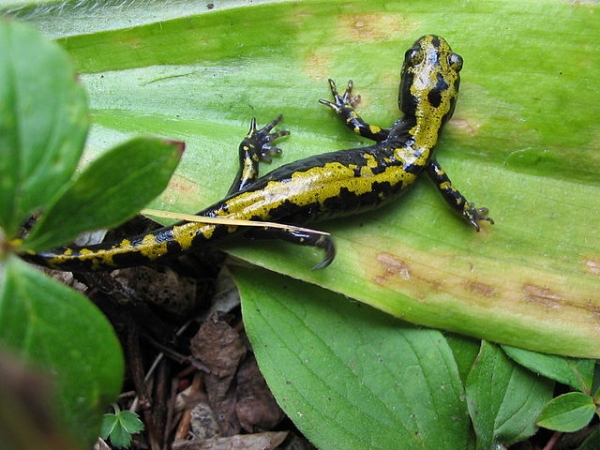
Image - Text Version
Shown is a close-up colour photograph of long animal on a large green leaf.
The animal is shown from above. Its skin is glossy with bright green down the centre of its back and long tail. Its sides are black with a pattern of splotches. It has four feet with long, webbed toes, and bulging, round eyes.
It sits on a green leaf that takes up most of the image. This leaf is surrounded by other, smaller leaves from different plants.
Amphibians of the Coastal Temperate Rainforest
Did you know that Canada is home to a rainforest? The coastal temperate rainforest is located where the continent meets the Pacific Ocean. All of the water in these rainy and humid forests creates great amphibian habitat.
Many species of salamanders, such as rough-skinned newts, live on the damp forest floor, where leaves and pieces of wood give them places to hide.
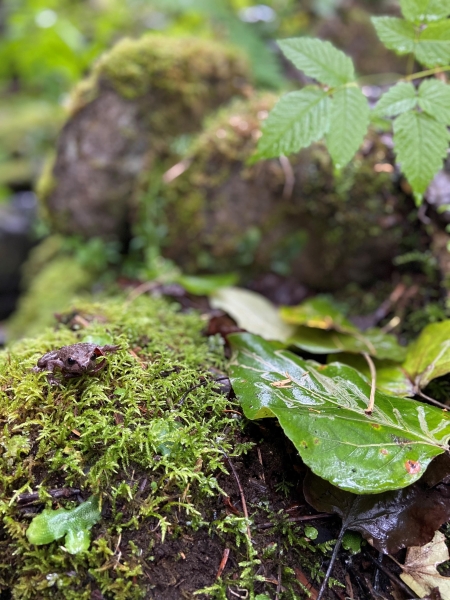
Image - Text Version
Shown is a colour photograph of a tiny brown frog almost hidden in moss.
The camera is close to the ground. The frog is so small, and so similar to the soil around it, that it is almost hidden. It is small, brown and shiny. the ground around is covered in green moss, moist brown soil and wet leaves. There are more moss and leaves visible in the background.
What can people do to help amphibians?
Amphibians aren’t the only ones who live in the coastal temperate rainforest. Many people live in this biome too. Whether cutting down trees to make wood for building homes, building a road to connect people, or building a pipeline so that people can heat their homes, humans have an impact on the biome. If a project cannot avoid areas where amphibians hang out, biologists trained in handling amphibians work to move amphibians out of harm's way so the work can get done without harming the amphibians that live there.
Even though amphibians cannot turn people into royalty, they are still truly unique animals, with very special habitat requirements. They are sensitive to many types of disturbances, especially climate change. Global warming can lead to more summer droughts and increased air temperatures. This can cause wetlands in the coastal rainforest biome to dry up, resulting in habitat loss for amphibians. Because of this, it is important for us to protect them and their habitat.
Let’s Talk Science appreciates the work and contributions of Diana Chomack and Sarah McLaughlin of Jacobs in the development of this Backgrounder.
About Jacobs
At Jacobs, we're challenging today to reinvent tomorrow by solving the world's most critical problems for thriving cities, resilient environments, mission-critical outcomes, operational advancement, scientific discovery and cutting-edge manufacturing, turning abstract ideas into realities that transform the world for good. With approximately $14 billion in revenue and a talent force of more than 55,000, Jacobs provides a full spectrum of professional services including consulting, technical, scientific and project delivery for the government and private sector.
Learn More
At-Home STEM Activities: Life Cycle of a Frog (2020)
This website contains information and fun activities for learning about the life cycle of frogs,
BC Reptiles and Amphibians
This website contains all of the information you need to get to know the amphibians in the coastal temperate rainforest,
Hinterland Who’s Who: Coastal Rainforest
This website contains lots of information about the coastal temperate rainforest.
References
British Columbia Ministry of Forests, Lands, and Natural Resources (June 2016). Best Management Practice for Amphibian and Reptile Salvages in British Columbia.
Canadian Herpetological Society (n.d.). Resources.
